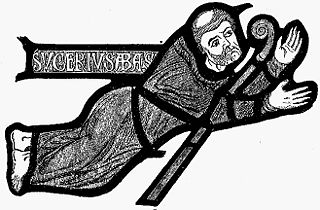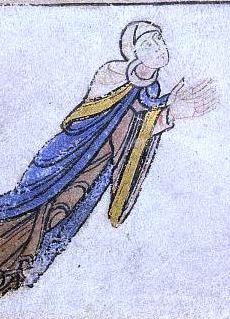Related Research Articles
The 1150s was a decade of the Julian Calendar which began on January 1, 1150, and ended on December 31, 1159.
Year 1124 (MCXXIV) was a leap year starting on Tuesday of the Julian calendar.
The 1120s was a decade of the Julian Calendar which began on January 1, 1120, and ended on December 31, 1129.
The 1130s was a decade of the Julian Calendar which began on January 1, 1130, and ended on December 31, 1139.

Year 1047 (MXLVII) was a common year starting on Thursday of the Julian calendar.

The Basilica of Saint-Denis is a large former medieval abbey church and present cathedral in the city of Saint-Denis, a northern suburb of Paris. The building is of singular importance historically and architecturally as its choir, completed in 1144, is widely considered the first structure to employ all of the elements of Gothic architecture.

Geoffrey V, called the Handsome, the Fair or Plantagenet, was the count of Anjou, Touraine and Maine by inheritance from 1129, and also the duke of Normandy by conquest from 1144. His marriage to Empress Matilda, daughter of King Henry I of England, led to the centuries-long reign of the Plantagenet dynasty in England. The name "Plantagenet" was taken from Geoffrey's epithet. Geoffrey's ancestral domain of Anjou gave rise to the name Angevin, and what became known as the Angevin Empire in the 12th century.
Theobald of Bec was a Norman archbishop of Canterbury from 1139 to 1161. His exact birth date is unknown. Some time in the late 11th or early 12th century Theobald became a monk at the Abbey of Bec, rising to the position of abbot in 1137. King Stephen of England chose him to be Archbishop of Canterbury in 1138. Canterbury's claim to primacy over the Welsh ecclesiastics was resolved during Theobald's term of office when Pope Eugene III decided in 1148 in Canterbury's favour. Theobald faced challenges to his authority from a subordinate bishop, Henry of Blois, Bishop of Winchester and King Stephen's younger brother, and his relationship with King Stephen was turbulent. On one occasion Stephen forbade him from attending a papal council, but Theobald defied the king, which resulted in the confiscation of his property and temporary exile. Theobald's relations with his cathedral clergy and the monastic houses in his archdiocese were also difficult.

Suger was a French abbot, statesman, and historian. He once lived at the court of Pope Calixtus II in Maguelonne, France. He later became abbot of St-Denis, and became a close confidant to King Louis VII, even becoming his regent when the king left for the Second Crusade. Together with the king, he played a part in the centralization in the growing French Kingdom. He authored writings on abbey construction and was one of the earliest patrons of Gothic architecture and is seen as widely credited with popularizing the style.

Adeliza of Louvain, sometimes known in England as Adelicia of Louvain, also called Adela and Aleidis; was Queen of England from 1121 to 1135, as the second wife of King Henry I. She was the daughter of Godfrey I, Count of Louvain.
William d'Aubigny, also known as William d'Albini, William de Albini and William de Albini II, was an English nobleman. He was son of William d'Aubigny and Maud Bigod, daughter of Roger Bigod of Norfolk.
Æthelgar was Archbishop of Canterbury, and previously Bishop of Selsey.
Henry Murdac was abbot of Fountains Abbey and Archbishop of York in medieval England.
Savaric fitzGeldewin was an Englishman who became Bishop of Bath and Glastonbury in England. Related to his predecessor as well as to Emperor Henry VI, he was elected bishop on the insistence of his predecessor, who urged his election on the cathedral chapter of Bath. While bishop, Savaric spent many years attempting to annexe Glastonbury Abbey as part of his bishopric. Savaric also worked to secure the release of King Richard I of England from captivity, when the king was held by Emperor Henry VI.

In the Rout of Winchester the army of imprisoned King Stephen of England, led by his wife, Queen Matilda of Boulogne, Stephen's brother Bishop Henry of Blois, and William of Ypres, faced the army of Stephen's cousin Empress Matilda, whose forces were commanded by her half-brother Earl Robert of Gloucester. After Empress Matilda's army besieged a castle on the edge of Winchester, Queen Matilda's army arrived and blockaded the Angevin army within the city. Cut off from supplies, the Angevin army gave up the siege, then was crushed as it began to retreat. Robert of Gloucester was captured and was subsequently exchanged for Stephen, who was returned to the throne of England. However, the civil war known as The Anarchy dragged on with neither side gaining an advantage.
Godfrey was a medieval Bishop of Bath.
Events from the 1150s in England.
Events from the 1120s in England.
Events from the 1100s in England.
Roger of London was an English Benedictine monk and Abbot of Selby Abbey from 1189 to 1195.
References
- ↑ Panton, James (2011). Historical Dictionary of the British Monarchy. Lanham, MD and Plymouth, UK: Scarecrow Press. pp. 205–206. ISBN 9780810874978.
- ↑ France, John (2001) [1999]. Western Warfare in the Age of the Crusades 1000-1300. Warfare and History. London: Routledge. p. 47. ISBN 9781135365073.
- ↑ Dutton, Kathryn (December 1, 2015). "Crusading and political culture under Geoffrey, count of Anjou and duke of Normandy, 1129–51". French History. 29 (4): 419–444. doi:10.1093/fh/crv014. ISSN 0269-1191.
- ↑ Bombaci, Alessio (1959). "Summary report on the Italian Archaeological Mission in Afghanistan. Introduction to the Excavations at Ghazni". East and West. 10 (1/2): 3–22. ISSN 0012-8376. JSTOR 29754076.
- ↑ Jaques, Tony (2007). Dictionary of Battles and Sieges: F-O. Vol. 2: F - O. Wesport, CT and London: Greenwood Publishing Group. p. 392. ISBN 9780313335389.
- ↑ "Iceland: 10 little-known facts". Daily Telegraph. August 18, 2009. ISSN 0307-1235 . Retrieved July 4, 2019.
- ↑ "Books and Bookmen". Books and Bookmen. 21: ccxliv. 1975 – via Google Books.
- ↑ Walbran, John Richard (1851). A Guide to Ripon, Harrogate, Fountains Abbey, Bolton Priory, and Several Places of Interest in Their Vicinity. Ripon and London: W. Harrison. pp. 113–114.
1151 Bolton Abbey.
- ↑ F.R.Hist.S., George R. Potter M. A. Ph d F. S. A. (December 15, 2009). "A note on the Devonshire papers at Ghatsworth House, Derbyshire". Journal of the Society of Archivists. 4 (2): 124–129. doi:10.1080/00379817009513947.
- ↑ Farrer, William; Clay, Charles Travis (2013). Early Yorkshire Charters: Volume 7, The Honour of Skipton. Cambridge Library Collection. Vol. 7: The Honour of Skipton. Cambridge, UK and New York: Cambridge University Press. pp. xi. ISBN 9781108058308.
- ↑ Chen, Wai-Fah; Duan, Lian (2014). Handbook of International Bridge Engineering. Boca Raton, London and New York: CRC Press. p. 915. ISBN 9781439810309.
- ↑ Schottenhammer, Angela (2001). The Emporium of the World: Maritime Quanzhou, 1000-1400. Leiden, Boston, Köln: BRILL. pp. 36–37. ISBN 9789004117730.
- ↑ Deng, Yinke (2011). Ancient Chinese Inventions. Cambridge, UK and New York: Cambridge University Press. p. 149. ISBN 9780521186926.
- ↑ Scott, Tom (2012). The City-State in Europe, 1000-1600: Hinterland, Territory, Region. Oxford and New York: Oxford University Press. p. 41. ISBN 9780199274604.
- ↑ Born, Lester K. (November 1927). "What is the Podestà?". American Political Science Review. 21 (4): 863–871. doi:10.2307/1947600. ISSN 1537-5943. JSTOR 1947600.
The first institution of the office of podestà was at Bologna in 1151
- ↑ Taruskin, Richard (2016) [1996]. Stravinsky and the Russian Traditions, Volume One: A Biography of the Works Through Mavra. Berkeley, Los Angeles: University of California Press. p. 90. ISBN 9780520293489.
- ↑ Romanova, Anna; Yakushenkova, Olesia (August 2012). Ching Chan, Selina (ed.). "Comparative Analysis of the Image of the Stranger in Chinese and Russian Discourse". Proceedings of the 7th Annual Conference of the Asian Studies Association. Hong Kong Shue Yan University - The Contemporary China Research Center: 1160. ISBN 978-988-18445-0-7.
An example of Igor Svyatoslavich the Brave’s life (1151-1202) is a good example of such types of relations with some nomadic tribes that lived close to the borders of Russian Kingdom.
- ↑ Vanina, Eugenia (2012). Medieval Indian Mindscapes: Space, Time, Society, Man. Delhi, India: Primus Books. p. 69. ISBN 9789380607191.
- ↑ Wiet, G. (1960). "al-ʿĀḍid li-Dīn Allāh" . In Gibb, H. A. R.; Kramers, J. H.; Lévi-Provençal, E.; Schacht, J.; Lewis, B. & Pellat, Ch. (eds.). The Encyclopaedia of Islam, New Edition, Volume I: A–B. Leiden: E. J. Brill. pp. 196–197. OCLC 495469456.
- ↑ Gheorghe, Alexandra (2012). "Natsume Sōseki's Yume Jūya ("ten Nights of Dream") and the Anarchetype – a Different Approach". Interstudia (Revista Centrului Interdisciplinar de Studiu al Formelor Discursive Contemporane Interstud) (11/1): 122–130. ISSN 2065-3204.
the narrator's unexpected meeting with the ancient wood carver, Unkei (1151 – 1223), famous for his sculptures from the temple Tōdai in Nara
- ↑ Wispelwey, Berend (2013). Japanese Biographical Index. Munich, Germany: Walter de Gruyter. p. 983. ISBN 9783110947984.
- ↑ Magill, Frank N. (1998). The Middle Ages: Dictionary of World Biography. London and New York: Routledge. p. 924. ISBN 9781136593130.
- ↑ Crosby, Sumner McKnight; Hayward, Jane; Little, Charles T.; Wixom, William D. (1981). The Royal Abbey of Saint-Denis in the Time of Abbot Suger (1122-1151). New York: Metropolitan Museum of Art. p. 15. ISBN 9780870992612.
- ↑ Grant, Lindy; Bates, David (1998). Abbot Suger of St-Denis: Church and State in Early Twelfth-Century France. London and New York: Routledge. pp. 286–287. ISBN 9781317899693.
- ↑ Inglis, Erik (September 1, 2015). "Remembering and Forgetting Suger at Saint-Denis, 1151–1534: An Abbot's Reputation between Memory and History". Gesta. 54 (2): 219–243. doi:10.1086/681955. ISSN 0016-920X. S2CID 163497330.
- ↑ Phillips, Lawrence Barnett (1871). The Dictionary of Biographical Reference: Containing One Hundred Thousand Names, Together with a Classed Index of the Biographical Literature of Europe and America. London: S. Low, Son, & Marston. pp. 11.
1151 Adeliza of Louvain.
- ↑ Dalton, Paul (2007). "The Date of Geoffrey Gaimar's "Estoire Des Engleis," the Connections of His Patrons, and the Politics of Stephen's Reign". The Chaucer Review. 42 (1): 23–47. doi:10.1353/cr.2007.0020. ISSN 0009-2002. JSTOR 25094383.
A terminus ante quern of 1151 might appear at first sight to be supported by references to Adeliza of Louvain, who died in 1151
- ↑ Panton, James (2011). Historical Dictionary of the British Monarchy. Lanham, MD and Plymouth, UK: Scarecrow Press. p. 18. ISBN 9780810874978.
- ↑ Teunis, H. B. (2006). The Appeal to the Original Status: Social Justice in Anjou in the Eleventh Century. Hilversum, Netherlands: Uitgeverij Verloren. p. 128. ISBN 9789065509048.
- ↑ Duffus Hardy, Thomas (1865). Rerum Britannicarum Medii Aevi Scriptores: Or Chronicles and Memorials of Great Britain and Ireland During the Middle Ages. Vol. II: From A.D. 1066 to A.D. 1200. London: Longman, Green, Longman, and Roberts. p. 245.
- ↑ Keefe, Thomas K. (1974). "Geoffrey Plantagenet's Will and the Angevin Succession*". Albion. 6 (3): 266–274. doi:10.2307/4048247. ISSN 0095-1390. JSTOR 4048247.
Count Geoffrey Plantagenet's sudden death in September 1151 came at a most inopportune time for his eighteen-year-old son, Henry.
- ↑ Chang, Kang-i Sun; Saussy, Haun; Kwong, Charles Yim-tze (1999). Women Writers of Traditional China: An Anthology of Poetry and Criticism. Stanford, CA: Stanford University Press. p. 89. ISBN 9780804732314.
- ↑ Kramarae, Cheris; Spender, Dale (2004) [2000]. Routledge International Encyclopedia of Women: Global Women's Issues and Knowledge. New York and London: Routledge. p. 1259. ISBN 9781135963156.
- ↑ Mann, Susan (2007). The Talented Women of the Zhang Family . Berkeley, Los Angeles, London: University of California Press. pp. 167. ISBN 9780520250895.
1151 Li Qingzhao.